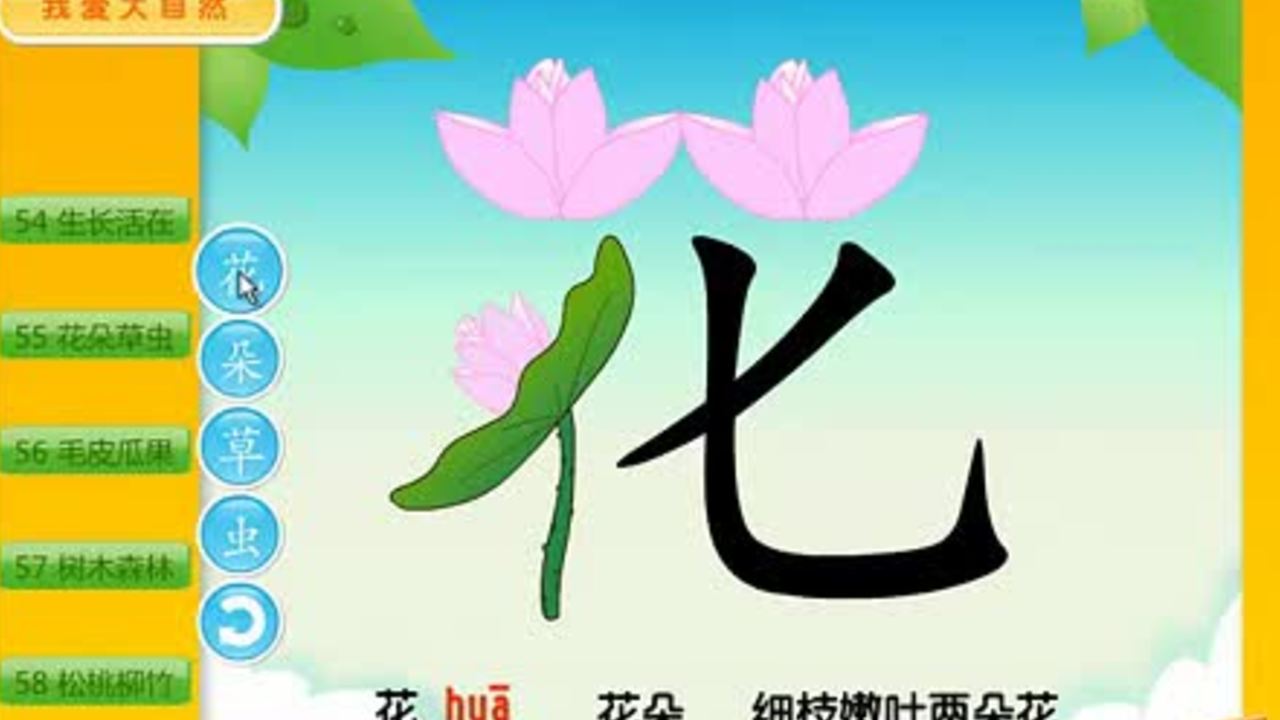
Chinese characters explained.

If you look at the characters related to plants, you will notice that most of them contain the "tree" or "grass" radicals.

If you look at the character for elephant, one might see a representation of the elephant with a long trunk, four legs and a tail. This is why Chinese is known as a "pictographic" language.

When you combine different Chinese characters, you can make different words. Let's now learn some terms for modes of transportation.

This cute introductory video helps Chinese learners learn the characters for "fu," (father) "mu," (mother) "ma," (mommy) and "ba" (daddy).

Learn in the fastest and easiest way possible how to effectively remember some characters that express movement.

Learn about the characters used to talk about time by watching this fun and thorough explanation of how to write them and how they came about.

Learn a simple, fun way to say the four directions in Chinese as well as how to remember how to write them.

Have you ever wondered why a Chinese character is written the way it is written? The Chinese characters are logograms, unlike the English language that utilizes Latin characters. The characters could be represented by pictograms depicting one or an aggregate of pictures or ideograms depicting an idea or a borrowed word. Join us to learn the roots of some of the Chinese characters. In this episode, you will discover the formation of "pine," "peach," "willow" and "bamboo."

Have you ever wondered why a Chinese character is written the way it is written? The Chinese characters are logograms, unlike the English language that utilize Latin characters. The Chinese characters could be represented by pictograms depicting one or an aggregate of pictures or ideograms depicting an idea/icon symbolically. Join us to learn the roots of some of the Chinese characters. In this episode, you will discover the formation of the "rind" of a fruit, "fur," "melon" and "fruit."

Have you ever wondered why a Chinese character is written the way it is written? The Chinese characters are logograms, unlike the English language that utilize Latin characters. The Chinese characters could be represented by pictograms, depicting one or an aggregate of pictures or ideograms depicting an idea/icon symbolically. Join us to learn the roots of some of the Chinese characters. In this episode, you will discover the formation of "horn," "flower," and "grass," to name a few.

As the story comes to a conclusion, we learn more and more concepts that are brilliantly captured in the essence of Chinese characters.

Learn not only the meaning behind some Chinese characters, but also how they were originally derived from pictures. These characters are of the agricultural variety.

While a father is teaching his child Chinese characters, they are introduced in all their wisdom and splendor.

Learn about the origin of some Chinese characters which were derived from pictures of what the characters represent.

Learn about the origin of some Chinese characters which were derived from pictures of what the characters represent.

The wisdom of Chinese ancient hieroglyphics can be traced back to thousands of years ago. They are so clever and yet, comprised of such spontaneous connections that even a child can guess them.

Innovation of a writing system occurs by creating a better version of what already exists, which is always related to one's national heritage.

Designing a new font is extremely difficult, especially since there are thousands of characters in the Chinese language.

Dean Lung, believing more people should understand China, made a great contribution to Columbia University.

In 1870, Horace Carpentier hired a loyal servant from China named Dean Lung who would eventually come to teach him a lesson in loyalty and devotion rooted in Chinese culture.

Zamenhof had a plan to create a world language, an ambitious plan thwarted by the innate quality of language itself.

The popularity of Christianity came to a peak during Matteo Ricci's time in China, but after his death, the Qing Dynasty vehemently opposed its practice in China.

The quest to discover Asia did not stop with Columbus. What has drawn other countries to China?

During the Ming Dynasty, the Chinese made the voyage across the Western Pacific. But, why was the feat not acknowledged in history?

The growing strength of China as an economic superpower is both a source of awe and concern for other countries.

It is becoming an increasing trend for schools to offer Chinese programs. Why are so many people turning to Chinese?

China is now an economic superpower, setting off a "Chinese Fever" that is now spreading all over the world.
Are you sure you want to delete this comment? You will not be able to recover it.